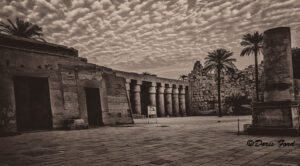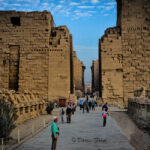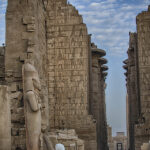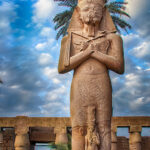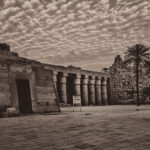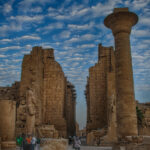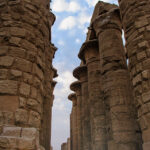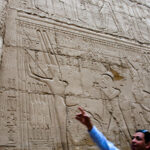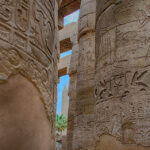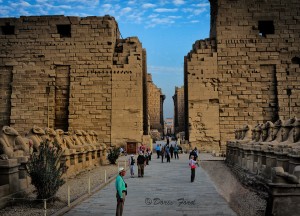

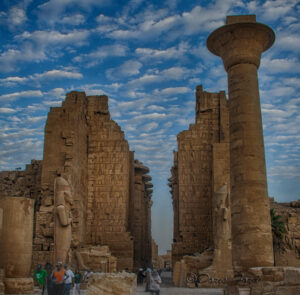
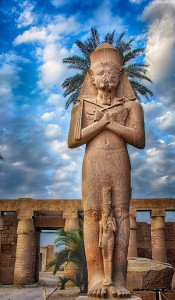

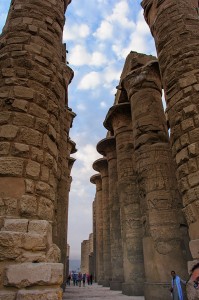
Sites of Egypt Colossi of Memnon
Amenhotep III (18th Dynasty) built a mortuary temple in Thebes that was guarded by two gigantic statues on the outer gates. All that remains now are the 23 meter (75 ft) high, one thousand ton statues of Amenhotep III. Though damaged by nature and ancient tourists, the statues are still impressive.
Ancient Egyptians called the southern of the two statues “Ruler of Rulers”. Later travelers called them “Shammy and “Tammy”, which may have been a corruption of the Arabic words for “left” and “right”. Today they are known locally as “el-Colossat”, or “es-Salamat”. The statues are made from carved blocks of quartzite quarried either at Giza or Gebel es-Silsila. The Northern statue depicts Amenhotep III with his mother, Mutemwia, while the southern statue is of Amenhotep III with his wife, Tiy and one of his daughters. On the sides of the statues are reliefs depicting Nile gods joining together plants symbolizing Upper and Lower Egypt.
The Colossi of Memnon (known to locals as el-Colossat, or es-Salamat) are two massive stone statues of Pharaoh Amenhotep III. For the past 3400 years (since 1350 BC) they have stood in the Theban necropolis, across the River Nile from the modern city of Luxor.[1][2]
Contents
1 Description
2 Name
3 Sounds
4 Gallery
5 See also
6 References
7 External links
Description
The twin statues depict Amenhotep III (fl. 14th century BC) in a seated position, his hands resting on his knees and his gaze facing eastwards (actually SSE in modern bearings) towards the river. Two shorter figures are carved into the front throne alongside his legs: these are his wife Tiy and mother Mutemwiya. The side panels depict the Nile god Hapy.
The statues are made from blocks of quartzite sandstone which was quarried at el-Gabal el-Ahmar (near modern-day Cairo) and transported 675 km (420 mi) overland to Thebes. (They are too heavy to have been transported upstream on the Nile.)The blocks used by later Roman engineers to reconstruct the eastern colossus may have come from Edfu (north of Aswan). Including the stone platforms on which they stand – themselves about 4 m (13 ft) – the colossi reach a towering 18 m (60 ft) in height and weigh an estimated 720 tons each [3][4][5] The two figures are about 15 m (50 ft) apart.
Both statues are quite damaged, with the features above the waist virtually unrecognizable. The western (or southern) statue is a single piece of stone, but the eastern (or northern) figure has a large extentive crack in the lower half and above the waist consists of 5 tiers of stone. These upper levels consist of a different type of sandstone, and are the result of a later (Roman Empire) reconstruction attempt. It is believed that originally the two statues were identical to each other, although inscriptions and minor art may have varied.
The original function of the Colossi was to stand guard at the entrance to Amenhotep’s memorial temple (or mortuary temple): a massive cult centre built during the pharaoh’s lifetime, where he was worshipped as a god-on-earth both before and after his departure from this world. In its day, this temple complex was the largest and most opulent in Egypt. Covering a total of 35 hectares (86 acres), even later rivals such as Ramesses II’s Ramesseum or Ramesses III’s Medinet Habu were unable to match it in area; even the Temple of Karnak, as it stood in Amenhotep’s time, was smaller.
Side panel detail showing two flanked relief images of the deity Hapi and, to the right, a sculpture of the royal wife Tiy
With the exception of the Colossi, however, very little remains today of Amenhotep’s temple. Standing on the edge of the Nile floodplain, successive annual inundations gnawed away at the foundations – a famous 1840s lithograph by David Roberts shows the Colossi surrounded by water – and it was not unknown for later rulers to dismantle, purloin, and reuse portions of their predecessors’ monuments.
Name
Memnon was a hero of the Trojan War, a King of Ethiopia who led his armies from Africa into Asia Minor to help defend the beleaguered city but was ultimately slain by Achilles. The name Memnon means “Ruler of the Dawn”, and was probably applied to the colossi because of the reported cry at dawn of one of the statues (see below). Eventually, the entire Theban Necropolis became generally referred to as the Memnonium.
Soundsn 27 BC, a large earthquake reportedly shattered the eastern colossus, collapsing it from the waist up and cracking the lower half. Following its rupture, the remaining lower half of this statue was then reputed to “sing” on various occasions- always within an hour or two of sunrise, usually right at dawn. The sound was most often reported in February or March, but this is probably more a reflection of the tourist season rather than any actual pattern. The description varied; Strabo said it sounded “like a blow”, Pausanias compared it to “the string of a lyre” breaking, but it also was described as the striking of brass or whistling. The earliest report in literature is that of the Greek historian and geographer Strabo, who claimed to have heard the sound during a visit in 20 BC, by which time it apparently was already well-known. Other ancient sources include Pliny (not from personal experience, but he collected other reports), Pausanias, and Juvenal. In addition, the base of the statue is inscribed with about 90 surviving inscriptions of contemporary tourists reporting whether they had heard the sound or not.
The legend of the “Vocal Memnon”, the luck that hearing it was reputed to bring, and the reputation of the statue’s oracular powers became known outside of Egypt, and a constant stream of visitors, including several Roman Emperors, came to marvel at the statues. The last recorded reliable mention of the sound dates from 196 (A.D.). Sometime later in the Roman era, the upper tiers of sandstone were added (the original remains of the top half have never been found); the date of this reconstruction is unknown, but local tradition places it circa 199, and attributes it to the Roman Emperor Septimius Severus in an attempt to curry favour with the oracle (it is known that he visited the statue but did not hear the sound).
Various explanations have been offered for the phenomenon; these are of two types: natural or man-made. Strabo himself apparently was too far away to be able to determine its nature: he reported that he could not determine if it came from the pedestal, the shattered upper area, or “the people standing around at the base”. If natural, the sound was probably caused by rising temperatures and the evaporation of dew inside the porous rock. Similar sounds, although much rarer, have been heard from some of the other Egyptian monuments (Karnak is the usual location for more modern reports). Perhaps the most convincing argument against it being the result of human agents is that it did cease, probably due to the added weight of the reconstructed upper tiers.
A few mentions of the sound in the early modern era (late 18th and early 19th centuries) seem to be hoaxes, either by the writers or perhaps by locals perpetuating the phenomenon.
The “Vocal Memnon” features prominently in one scene of Henrik Ibsen’s Peer Gynt. They also show up in Oscar Wilde’s fairy tale “The Happy Prince.”
Read more: http://www.touregypt.net/collmem.htm#ixzz2d8EYYjAR
